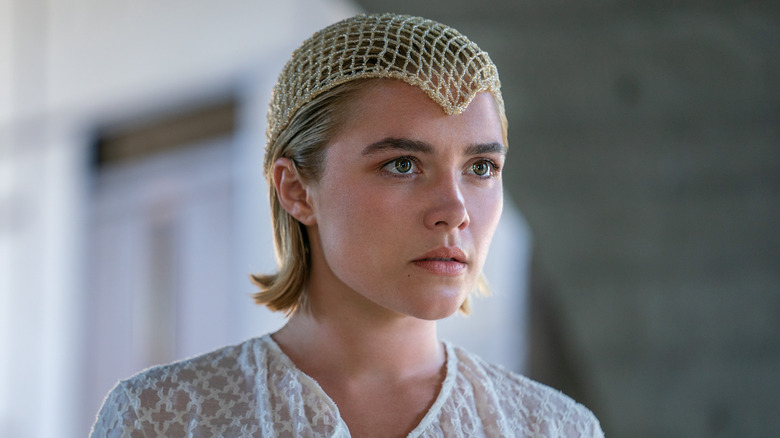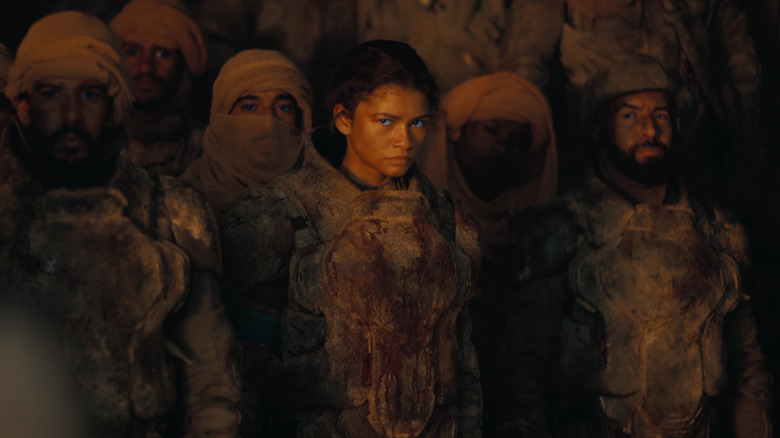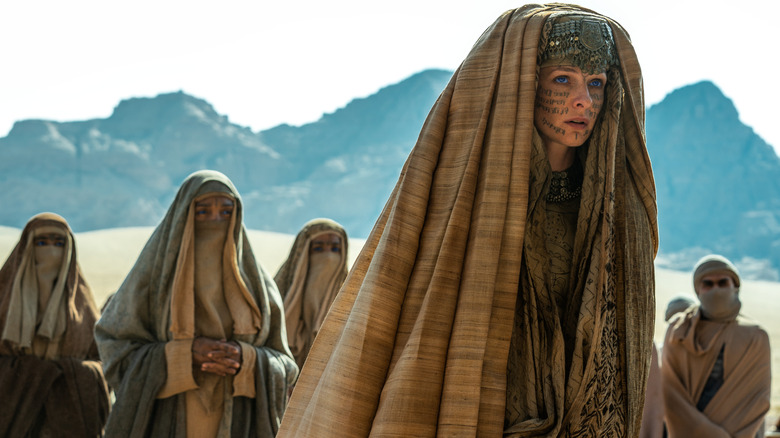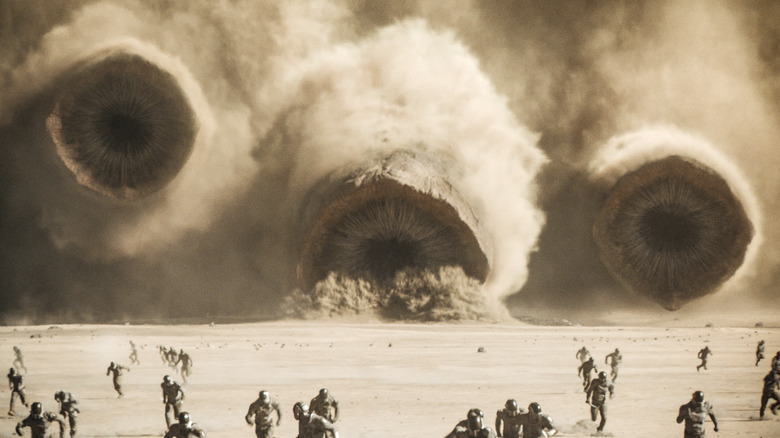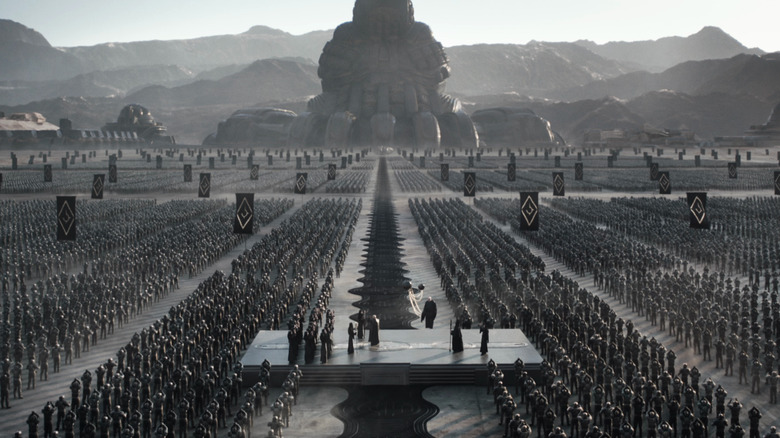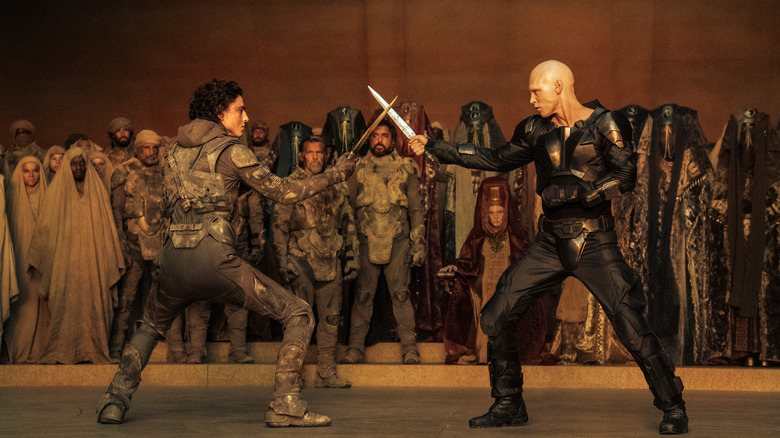Why Dune 2 Blew Everyone Away At The Box Office
"Dune: Part 2" has arrived, and, not surprisingly, the film's opening weekend was as epic as the story itself. The space opera soaked up headlines and blew up the box office as it spectacularly entertained audiences, raking in a cool $81.5 million.
There are countless factors that set apart director Denis Villeneuve's triumphant adaptation of Frank Herbert's literary masterpiece. Some of these seeds of success were sown years ago when the film's predecessor, "Dune: Part 1," was warmly received despite releasing during the cinematically hostile pandemic environment. Other components are woven into the fibers of the sequel itself. From immaculate casting to superb special effects and much more, there are plenty of reasons "Dune: Part 2" is set for an incredible theatrical run.
What factors played the biggest part in the film's immediate success, though? What were the elements that had fans flocking by the thousands to their nearest theater to see Paul Atreides' second act the moment it was available? What was it that gave this film a must-see feeling? Here are some of the top reasons "Dune: Part 2" performed so well on opening weekend.
Sequels sell
We live in an age of sequels. Look no further than the biggest entertainment brand of them all for proof. In late 2023, Disney CEO Bob Iger revealed that the Mouse House will react to the struggling entertainment economy by reducing production and — drum roll, please — focusing on sequels and franchises. Why return to past IPs? Because sequels sell, especially when it comes to popular franchises — and the first of director Denis Villeneuve's "Dune" films proved that Frank Herbert's world is ready to deliver 21st-century dividends.
The power of the sequel attracts audiences, especially when the previous movie is a proven commodity. "Dune: Part 1" was received with rapturous acclaim when it was released in 2021, and it continues to boast an 83% critic score and 90% audience score on Rotten Tomatoes.
The first film succeeded for several reasons. It flawlessly achieves everything you want in the first act of a multi-part story. The world-building is mesmerizing. Audiences are expertly introduced to a lot of characters. The tragic story of the House of Atreides is established and moved forward to its initial tragedy shortly after it assumes command of the highly coveted spice-world of Arrakis. As the sand settles and the credits roll, it leaves audiences begging for more of the same. As such, they flocked to cineplexes for the sequel, spurred on by a wave of early reviews that had critics once again united in praise.
A stellar cast sets the stage for success
It's hard to over-hype the cast behind the "Dune" reboot. Every time the scene shifts or the camera pans, another famous face is waiting to soak up the limelight. The obvious headliner is Timotheé Chalamet's Paul Atreides. However, he's not alone. The young actor is backed by an all-star cast that includes the likes of Josh Brolin (as Gurney Halleck), Zendaya (as Chani), Stellan Skarsgård (as Baron Vladimir Harkonnen), Rebecca Ferguson (as Lady Jessica Atreides), David Bautista (as Glossu Rabban Harkonnen), Javier Bardem (as the Fremen leader Stilgar) — the list goes on.
Some characters, like Oscar Isaac's Duke Leto Atreides and Jason Momoa's Duncan Idaho, didn't make it through the first film alive, but "Dune: Part 2" promises to bring a fresh batch of recognizable faces in their wake. The sequel includes, among many others, Austin Butler as the villainous Feyd-Rautha, Florence Pugh as the Princess Irulan, and Christopher Walken as Shaddam IV, the almighty Emperor of the "Dune" universe.
It's hard to find another series with so many powerhouse names delivering stellar performances side by side. Director Denis Villeneuve's overarching guidance has brought the story to life in new and exciting ways, and no one can take away what the man has accomplished. But there's no mistaking the fact that the French Canadian director is working with an extraordinary cast, and audiences know it.
Finally seeing the Fremen
The Fremen are a huge part of Frank Herbert's universe. They simultaneously fill the heartbreaking role of a suppressed indigenous people cast aside and deprived by commercial greed as well as that of the Spartan-like indomitable soldier. From their honor-bound approach to warfare, to their pragmatic handling of hydration, it's endlessly entertaining every time the Fremen — and especially their Naib (leader) Stilgar — show up on the scene.
The Fremen are such a great part of the "Dune" universe that their under-utilization was one of the biggest shortcomings in the first movie. It isn't Denis Villeneuve's fault, though. By splitting Frank Herbert's first novel into two movies, the two-part "Dune" adaptation naturally compartmentalized most of the Fremen-focused action into the sequel. Along with seeing more of the Fremen in general, "Dune: Part 2" gives us a lot more of Zendaya's Chani, who was the most common Fremen face seen in Part 1. However, she primarily appears in Paul's visions with little to no context.
Chani and the Fremen play a critical role in the rest of the story despite barely getting any screen time in the first film. Now that "Dune: Part 2" is out, audiences can finally see more of Chani's story, along with more details about her people's hidden life holed away in their arid enclaves across Arrakis' desert landscape. It's a factor that doubtless attracted curious casual viewers and diehard "Dune" superfans alike on opening weekend.
The power of the cliffhanger ending
Frank Herbert's first book in the "Dune" series ends on a bit of a cliffhanger. Denis Villeneuve's "Dune: Part 1" runs into a similarly open-ended — arguably even more frustrating — conclusion. In doing so, it leaves audiences at an utterly low point. The movie spends two and a half hours building up the story, only to have everything come crashing down in ruin for Paul and the rest of his family and friends.
In the third act of the film, the Harkonnens reinvade Arrakis, the family patriarch Leto is killed, and Paul and his mother Jessica find themselves in exile on the hostile, sand-covered surface of the planet. They narrowly survive a sandstorm and a sandworm and run right into Stilgar and his Fremen warriors — including Chani. There is an initial confrontation in which Jessica proves her might and Paul makes his first kill by dispatching the militant Jamis (Babs Olusanmokun).
After that, the group heads off to find shelter. Then, the movie ends. Just like that. Paul's life is in shambles, his father is dead, and his inheritance is lost. Nothing could be further from the concept of closure. When you leave that many loose ends to a truly spectacular movie, it is almost guaranteed to bring everyone back for round two.
The sandworm factor
Who doesn't love a massive movie monster? If there was ever a monstrous big screen creature fit to captivate audiences, it would be the sandworms of Arrakis. These beasts can extend to hundreds of meters long (many times the length of a Blue Whale, the largest known animal to have ever lived). They are fiercely protective, and come racing toward the slightest rhythmic footstep of an invader. At least, that's the wild, threatening sandworm that we saw in "Dune: Part 1."
However, even those who weren't really paying that much attention knew by the end of the first movie that there was more to the sandworms than that. We even get a glimpse of a distant Fremen riding a sandworm at one point in that film, and the marketing for "Dune: Part 2" made it clear early and often that the sequel was going to take that epic ride to the next level.
In Herbert's books, the Fremen practice the deft art of catching and riding sandworms. They use them to travel vast distances, and there's no doubt that the beasts have a ton of potential as oversized weapons of war, too (Paul himself notes their potential as "desert power" in the first movie). The chance to see a whole lot more of these giant creatures in all of their cinematic glory was one of the flashiest selling points of the sequel, and it made a trip to the theater as early as possible a necessity for many.
A theatrical redemption story
Another quiet yet profound factor driving the success of "Dune: Part 2" stretches back to the pandemic days. "Dune: Part 1" came out during some of the bleakest moments of that global crisis, and it was long before everyone was comfortable returning to theaters in crowds. With social distancing still in effect, many opted for the alternative viewing option: Streaming the experience on what was then HBO Max.
This divided experience meant streaming audiences were cannibalizing theatrical revenue in real-time, and it led to relatively muted box office numbers that totaled under half a billion globally when all was said and done. While often touted as an impressive box office success under the circumstances, the truth is, "Dune: Part 1" could have done much better if the pandemic hadn't derailed its theatrical release.
Its sequel gave many fans a chance to finally see Villeneuve's vision in its cinematic glory. For the millions of fans who were forced to watch the first film at home, "Dune: Part 2" was a chance at theatrical redemption, and they seized the opportunity to see the big-screen treatment of the story at the first possible opportunity.
A pre-existing audience
Any "Dune" adaptation has the luxury of coming with a built-in audience. The original book has sold over 20 million copies since it was written in the mid-1960s. It has also been translated into over 20 languages, making it one of the big international best-selling sci-fi stories of the 20th century. The original book was the first of half a dozen primary "Dune" novels, which served as a core that spawned over two dozen total books set in the "Dune" universe.
Denis Villeneuve's 21st-century telling of the story is hardly the first adaptation of this massive literary experience, too. David Lynch famously adapted the story in the 1980s. Alejandro Jodorowsky tried and failed to bring his bizarre vision for "Dune" to life, too, and William Hurt even starred in a forgotten "Dune" miniseries that was released around the turn of the century. Despite the enduring popularity of Herbert's novels, though, none of these projects properly channeled the author's epic until Villeneuve's two-part magnum opus.
For decades, "Dune" has been slowly building a fan base that is millions strong. Over that time, multiple attempts have been made to recreate his interstellar magic on screen, all to no avail — until "Dune: Part 1" blew fans away a couple of years ago. Coming off of that incredible experience, there was no doubt that the "Dune" fandom would lead the charge to see the sequel, supercharging its opening weekend in the process.
The power of IMAX
IMAX films often perform well at the box office — look no further than the recent box office success of "Oppenheimer" as proof. In this case, there are multiple reasons the mega-screen factor influenced the opening weekend figures. One of these is the allure of a movie specifically filmed to be displayed on a massive screen. During a Warner Bros. panel at CinemaCon, it was reported that 100% of "Dune: Part 2" was filmed on IMAX cameras. In comparison, just 40% of "Dune: Part 1" received the same treatment. The first part of the story already looks about as epic as it gets. The thought that the sequel would up the ante, visually speaking, sent the message that watching the movie in theaters was a must-see experience.
The other IMAX factor at play here is the cold, hard calculation of dollars and sense. IMAX tickets tend to cost more than a normal movie ticket. This can influence the box office totals, making one movie appear more popular than another even if there aren't technically more butts in the seats. While this is a factor, there's no doubt that "Dune: Part 2" had plenty of people buying tickets on opening weekend. The slightly inflated IMAX prices were just a bonus for an already impressive haul.
Delayed gratification
When someone can't have something, they often want it more — and faster. The wait for "Dune: Part 2" was already a multi-year affair. The movie was initially supposed to be released on October 20, 2023 — two years after the first movie simultaneously hit theaters and streaming screens. Of course, that initial release window was set before 2023 became known as the year of Hollywood strikes. The ensuing turmoil first saw "Dune: Part 2" pushed back to November 2023 before being officially delayed to March of the following year.
After such an enticing first installment, the delay was maddening for fans who were desperate to see director Denis Villeneuve bring Paul Atreides' cliffhanger of a story to some kind of conclusion. Of course, the sequel isn't the final act in the "Dune" drama by any stretch of the imagination. Nevertheless, anything would be more conclusive than the ending of the first film, and waiting to see the story develop further felt like an endlessly delayed process. The lengthy wait (nearly two and a half years when all was said and done) ensured that everyone was fired up and ready to rumble when the time for all-out war on Arrakis finally arrived.
Finally getting to the action and adventure
As weird as it sounds, "Dune: Part 1" is the slow part of the "Dune" story arc. It spends a lot of time introducing characters, establishing important historical elements, and building up the world itself. The end of the movie is pretty action-packed as the Harkonnens conduct a genocidal war against the House of Atreides, and there's no doubt that the movie is an easy two-and-a-half-hour watch. And yet, when you sum it all up, there really isn't that much going on — especially compared to the second half of the book.
Most of the story's biggest action sequences are reserved for the second film. Director Denis Villeneuve himself admitted that "Dune: Part 2" has more bite to it during an interview with Total Film. "It's more of an action film than the first part," he said. "It's more muscular." The sequel has more adventure, higher stakes, all-out war, and, of course, sandworms. Lots of sandworms. It's where the rubber hits the road, and audiences knew they were in for an action-packed treat heading into opening weekend.
An ideal box office climate
The box office of 2024 isn't what it used to be. On one hand, there has been a steady stream of box office bombs over the last year or so. Many of these have been tentpole events, such as "The Marvels," "Transformers: Rise of the Beasts," and "The Flash." On the other hand, certain films managed to soak up the limelight. Both "The Super Mario Bros. Movie" and "Barbie" raked in over a billion dollars each at the box office in 2023. "Barbie" also combined with Christopher Nolan's "Oppenheimer" to create a uniquely synergistic theatrical success for both films.
The takeaway is that there is no obvious theatrical formula at the moment: Many expected successes end up being flops and the box office has consolidated into a few major movie events each year. This made the timing of the "Dune" sequel's release a key part of its initial momentum. The movie came out well after the holidays and at the end of winter, giving cooped-up audiences a reason to get out of the house. The film was also released with minimal competition, making it easily the top option for most moviegoers. Put it all together, and the delayed release window ended up being a blessing in disguise.


